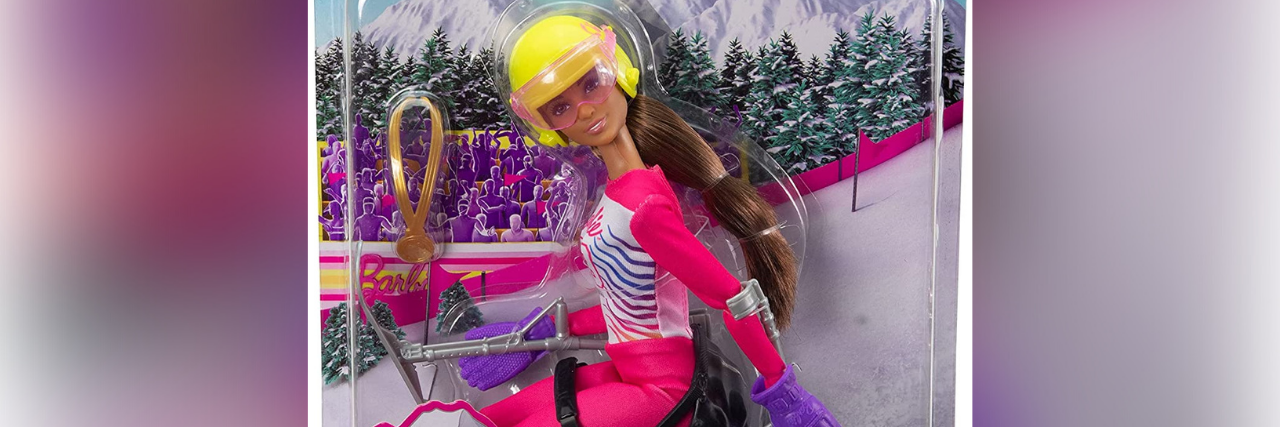In anticipation of the 2022 Winter Olympics and Paralympics, Mattel released a new collection of Barbie dolls featuring — among other Barbie winter sports stars — a para skiing doll. The doll, who sits on adaptive skis and comes with a championship medal toy, is the sole representation of disability in the latest Barbie collection. But that’s not the only reason the doll stands out — it’s a representation so powerful that the International Paralympic Committee and people with disabilities everywhere are lauding how it can help children with disabilities feel seen during playtime and beyond.
Since Mattel first committed to including Barbie dolls with disabilities in their 2019 Barbie Fashionistas line, people with disabilities have been vocal about how edifying it would have been to see dolls with disabilities when they were growing up. After all, prior to the launch of the 2019 Fashionistas line, Barbie dolls looked fairly homogenous — extremely tall and slender and exclusively able-bodied. To many, featuring Barbie dolls with disabilities felt well overdue — Barbie devotees may remember the then-singular Wheelchair Barbie doll‘s discontinuation in 1997 after manufacturers discovered her wheelchair couldn’t fit inside the coveted Barbie Dreamhouse. Wheelchair users and others with physical disabilities have spent years being hidden away in the Barbie world and consequently playing with dolls that didn’t fully represent them. And to complicate matters, athletic dolls with mobility challenges seemed to be as elusive as an accessible entrance to a Barbie Dreamhouse — until now.
I was one of the many children who owned a myriad of Barbie dolls with the conspicuous exception of one — a doll with a physical disability. Throughout my childhood, I spent hours playing with Barbie dolls but as a young girl with cerebral palsy, it was hard not to internalize able-bodied Barbie dolls as pillars of unattainable femininity. Every Barbie doll I played with was tall, slender, stylish, and noticeably able-bodied. The Barbie I knew wore high heels, not leg braces. She didn’t have surgery or attend physical therapy multiple times per week. And while she didn’t play sports often, she didn’t lag behind her friends or play alongside Barbie dolls with disabilities. Barbie’s life looked so simple — so foreign from my life with a disability.
My girlhood years spent playing with able-bodied Barbie dolls weren’t at all responsible for my later decision to hide my disability or for the years of anxiety, depression, and anorexia that would follow, but they can’t have helped matters. I spent my first few years of adulthood seeing disability represented in more ways than ever — from the advertisements on TV to the personal narratives I read — but I still held a sense of longing for the childhood I never had — the sense of representation I sought but could never seem to find. I even stumbled across blogs by disability advocates who exposed the truth behind wheelchair Barbie’s silent departure — but I didn’t see many retailers showcasing dolls with disabilities. On the rare occasion companies rolled out disabled dolls, the dolls seemed to have no defining traits outside of their disabilities — they weren’t portrayed as high-powered career women, and they certainly weren’t sports stars. They simply existed, and we were expected to believe their presence in the doll universe was enough.
But I — and so many others — wanted more, and when Mattel released para skiing Barbie, we watched our childhood hopes and dreams come true.
I never could have dreamed that Mattel would release a Barbie who’s a para skiing champion, but I’m now celebrating alongside fellow people with disabilities who’ve craved this type of representation for years. With brunette hair swept back into a perky ponytail and pretty, pink skiing accoutrements, para skiing Barbie seems like any other doll — but she’s so much more than a fierce, fashionable champion. Mattel’s new para skiing Barbie is a sign to any little girl who feels “too disabled” to be an athlete that she can follow her dreams — and that her disability can never make her look any less fabulous than her able-bodied peers. It’s a beacon of hope for the disabled girls of today — and the little disabled girls we once were — that we deserve to be represented in the sports world… and everywhere else.

